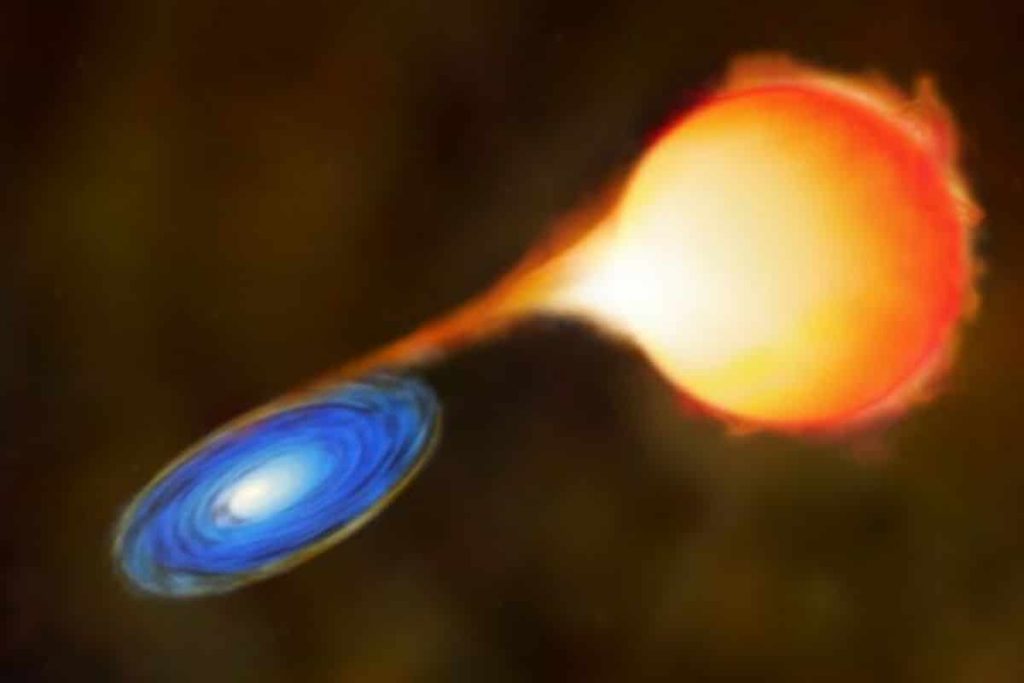This “mini” star appears to have been robbed by a greedy neighbor.
Meanwhile, millions of red giant stars have already been found in our Milky Way. These gorgeous, luminous celestial bodies are predictive of what our Sun will look like in about four billion years. For some time, astronomers have speculated that in addition to the regular red giants, there are also “slender” giants. And now, for the first time, such “misfits” have been discovered.
More about the red giants
Nuclear fusion occurs in stars. In this process, hydrogen is converted to helium. But at some point, such a star will run out of hydrogen. Due to the lack of energy the star shrinks as the temperature rises to more than 100 million degrees. The intense heat leads to a new process, fusion of helium into heavier atoms such as carbon and oxygen. The superheated core then expels the star’s outer layers, causing it to swell hundreds of times its original size, turning the star into a red giant.
“It’s like finding Waldo,” said study researcher Yaguang Li. “We were very fortunate to discover about 40 skinny red giants hiding in a sea of ordinary stars. These smaller red giants are either smaller or less dense than regular red giants.”
Discovery
The researchers tracked the slender red giants using data collected from the now retired Kepler space telescope. From 2009 to 2013, this telescope continuously recorded brightness differences for tens of thousands of red giants. Using this incredibly large and accurate data set, the team performed a comprehensive census of this star cluster. This laid the groundwork for discovering misfits.
unusual stars
The team encountered two types of unusual stars: very low-mass red giants and less bright red giants. The bright stars weigh only 0.5 to 0.7 solar masses – about half the weight of our sun. This indicates that these stars have somehow lost mass. Otherwise, this means that these stars are older than the universe, which, of course, is impossible. “When we first got the masses of these stars, we thought there was something wrong with our measurements,” Lee says. “But it turns out that’s not the case.”
On the other hand, less bright stars have normal masses – 0.2 to 2.0 times the mass of our Sun. “However, these are much smaller than we expected,” said study researcher Simon Murphy. “So they have shrunk their size. Because they are smaller in size, they are also much fainter compared to normal red giants.”
lost weight
Why did these skinny red giants lose so much weight? It is possible that these smaller specimens were stolen by the greedy neighbor. This is correct. Most of the stars in the night sky are in what are called binary systems – two stars bound together by gravity. When such narrow-orbit binary stars expand—as stars do with age—one star can suck material away from the other.
Asterose science
Researchers were able to reveal the properties of the studied red giants thanks to seismology – the study of stellar oscillations. Using traditional methods of studying a star, astronomers often get no further than surface properties, such as temperature and brightness. But seismology makes it possible to look indirectly into the interior of a star by means of sound waves. “The waves penetrate the interior of the star, providing more information,” Lee told me.
Thanks to the study, we are beginning to better understand the variety of stars that shine in the night sky. “By carefully sifting through data from NASA’s Kepler space telescope, Lee discovered something that everyone has missed so far,” said study co-author Tim Beding.

“Lifelong entrepreneur. Total writer. Internet ninja. Analyst. Friendly music enthusiast.”











More Stories
Monster Jam Showdown Launch Trailer
The European Digital Twin Ocean prototype reveals many possibilities
Instagram now lets you add a song to your account